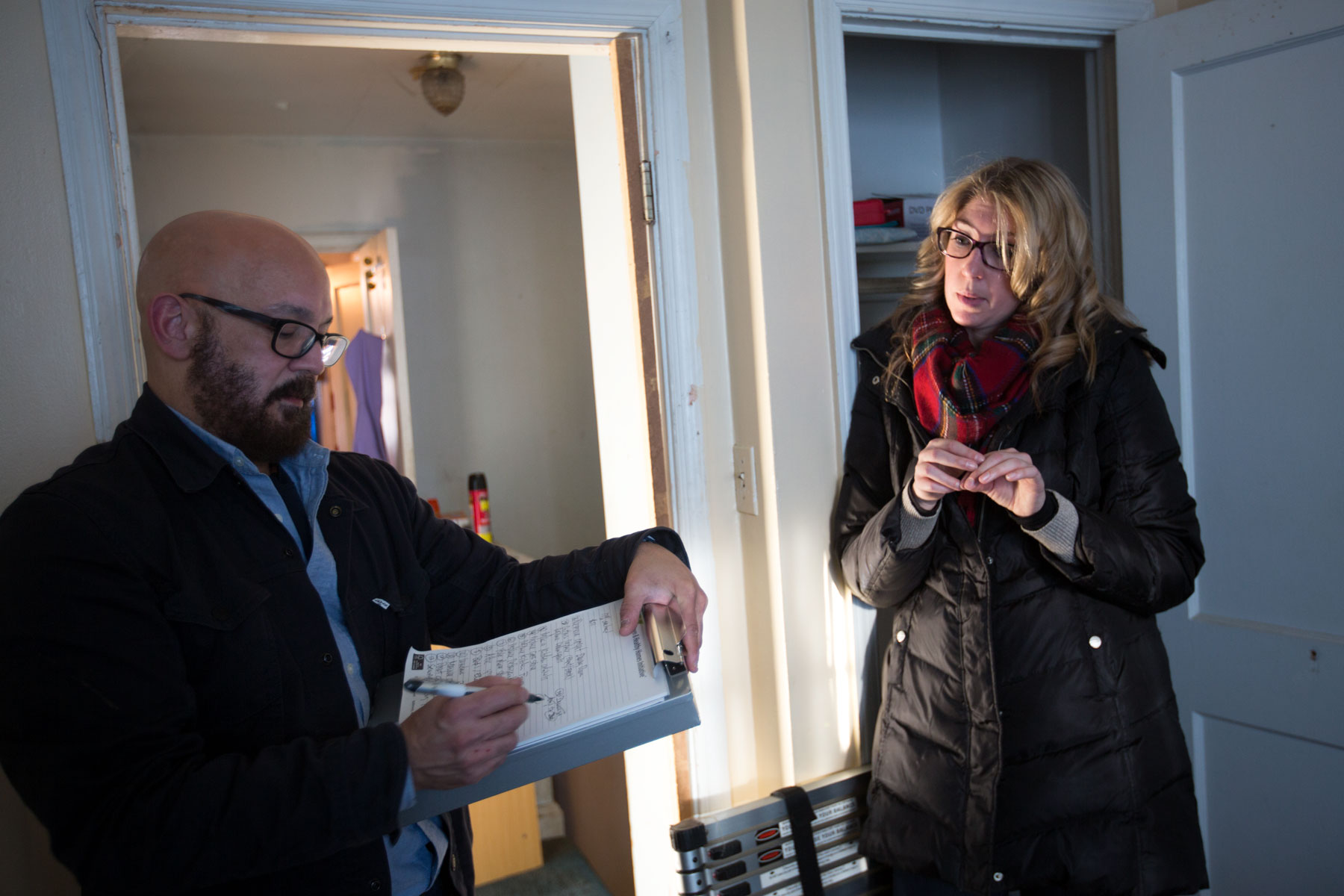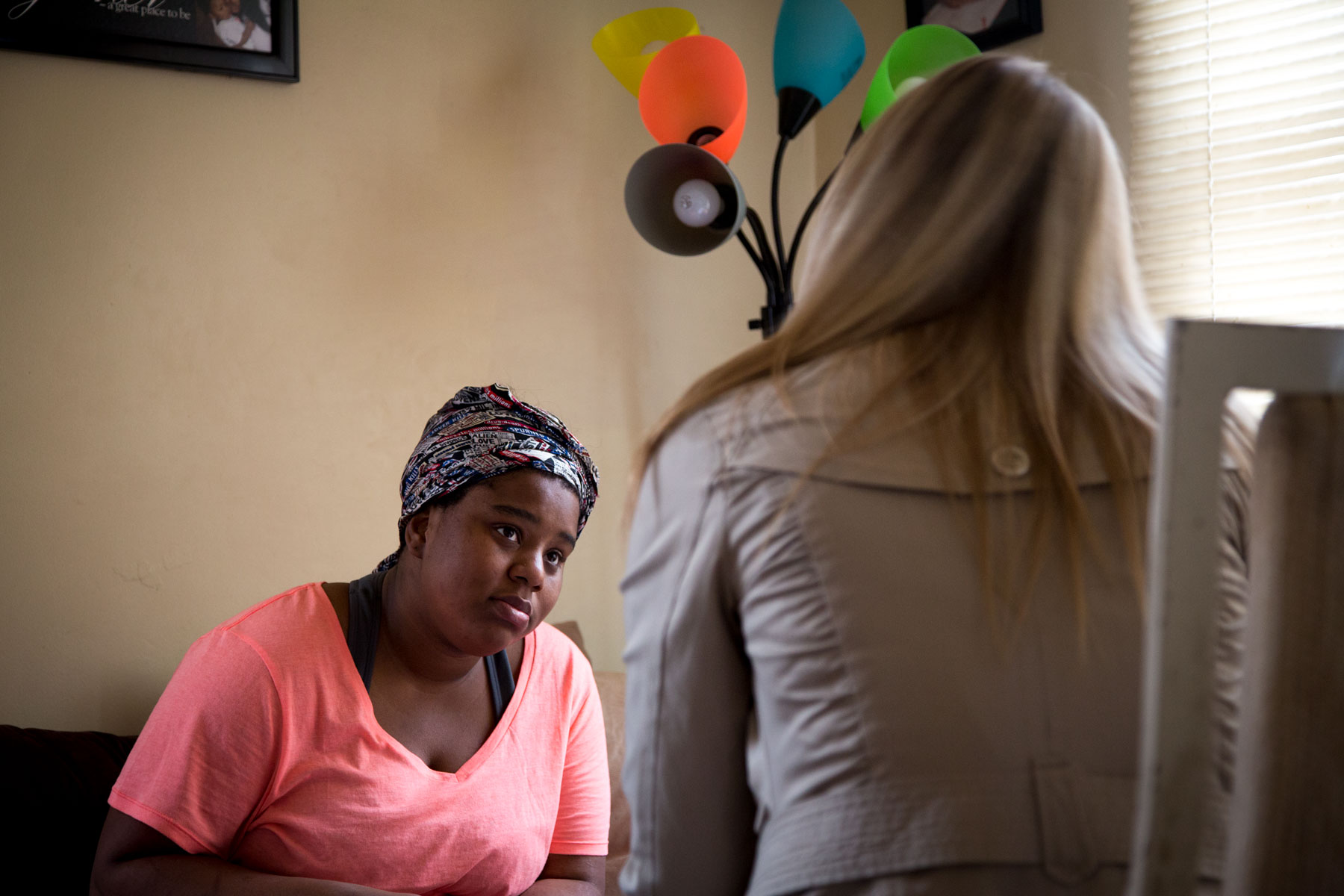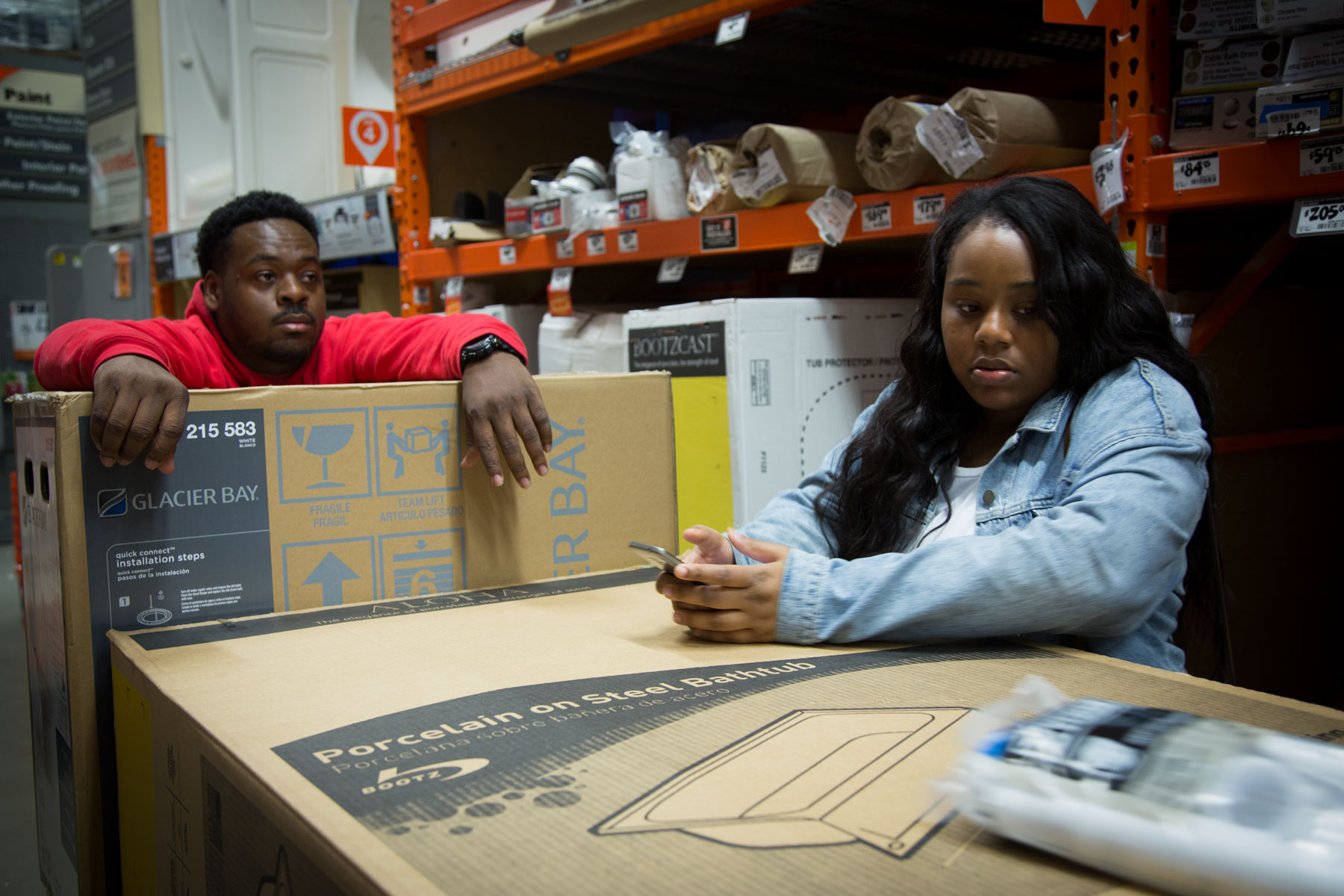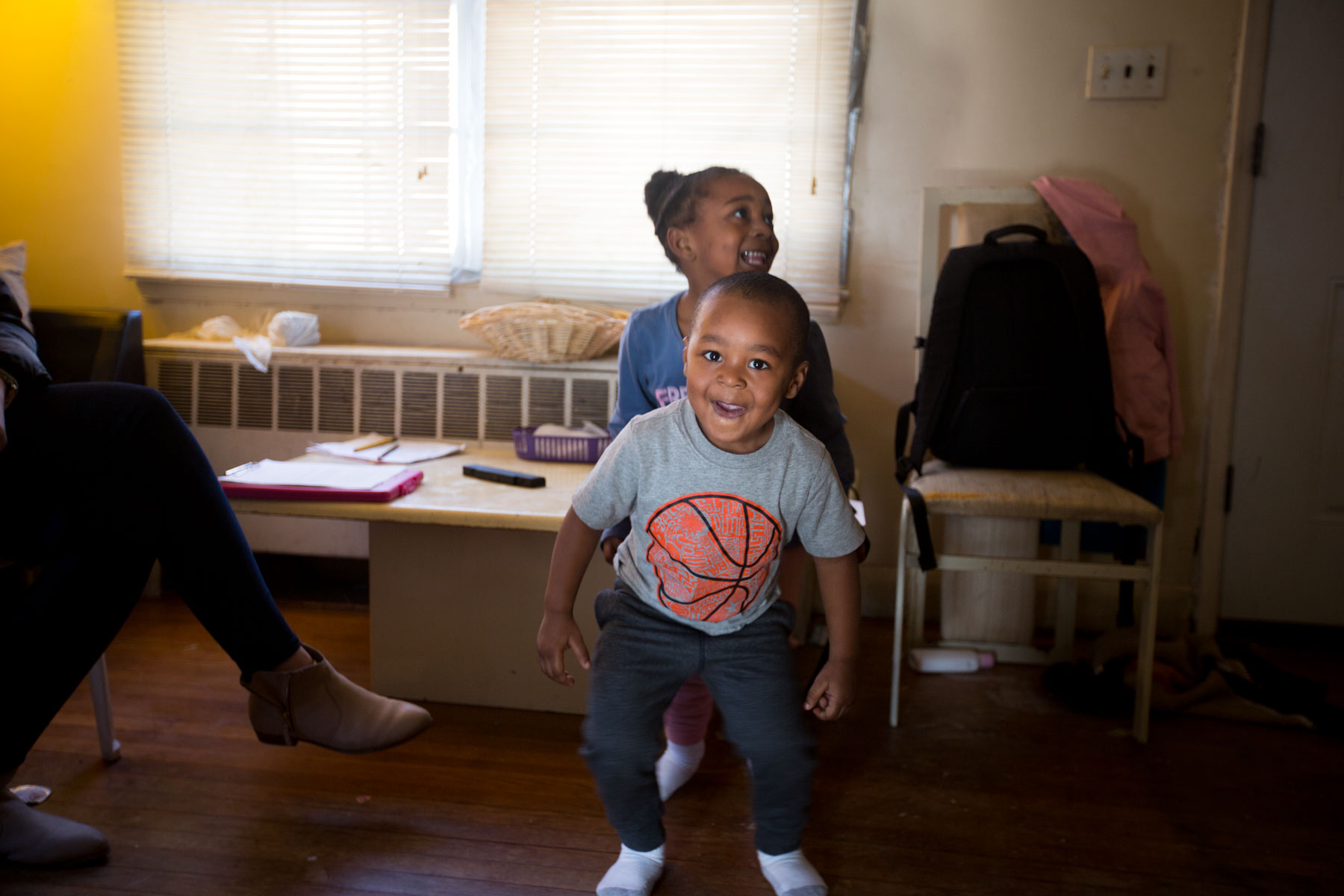Homesick
Having a safe and healthy home is a foundation for the entire family
Photography and Writing by MATTHEW JOHNSON
Brittany Corprew sat under the glow of the Christmas lights that lit up her drafty living room. It was December and the weather was starting to turn in Arlington, the northwest Baltimore neighborhood to which this 24-year-old mother and her family had recently relocated.
As she sat pressed up against her 26-year-old fiancé, Dominic Wade, Brittany inventoried the house’s many problems: bug-infested rooms, broken gutters, a leak in the basement, and paint peeling off the walls. But despite all these problems, the house was theirs.
Dominic’s parents gave it to them so they could have a rent-free home to raise their children in. Brittany and Dominic just had to figure out how to afford a slew of much-needed repairs.
“We were kind of scared,” Brittany said. “Where are we going to get the money from? How are we going to do it? It was in pretty bad shape.”


Dominic was well aware that the house was deteriorating before they moved in, because he grew up in it. Brittany had lived in it too when the couple first got serious, moving in as Dominic’s parents moved out and down the street. The house affected Brittany’s asthma even before she and Dominic had children. But after the birth of their daughter, Peyton, and their son, Dominic Jr., they were forced to move into Brittany’s grandmother’s downtown home for the sake of their children’s health and their own.
But even after the family moved downtown, things did not improve much. All four family members shared one mattress in a single bedroom for two years. The house was full of pets, and Brittany and her children suffered multiple asthma attacks requiring visits to the emergency room.
So they moved back to Arlington, determined to find a way to make it work; to fix the house and build a healthier life in it.
As Brittany sat on the couch on that December day, her brother, Stephinol, came through the door with Peyton in his arms. In Peyton’s tiny hand was a pamphlet that her Head Start teacher had given to her during school. And inside that pamphlet was an answer this family was desperately seeking.
The case for a healthier home
Hector Moreno suspiciously eyed the paint chips dangling from the columns in front of the house. The pattern formed by the chips on the wood resembled the texture of alligator skin, usually a telltale sign that the paint contains lead—a serious health risk, especially for children.
Dangerous lead exposure is a widespread problem across the United States, and lead paint, often found in older houses, is the leading culprit. Baltimore has been particularly pained by lead: the Centers for Disease Control and Prevention reported in 2014 that 7.2 percent of children tested in Baltimore had blood lead levels exceeding 5 micrograms per deciliter, an even higher mark than the most recent estimates for children living in Flint, Michigan.
Moreno inspects houses for the Green & Healthy Homes Initiative (GHHI), a Baltimore-based organization that sprung from the Coalition to End Childhood Lead Poisoning. For the past 30 years, these organizations have worked to eliminate lead as a health risk in Baltimore’s low-income homes and, in more recent years, to mitigate conditions that lead to asthmatic symptoms.



It didn’t take long for Moreno to recognize that Brittany and Dominic’s house contained immediate health risks.
Beyond the paint chips, he found a weakening roof, mold and water damage, ventilation and insulation issues, a withering porch and deck, a dysfunctional furnace, a broken water heater, a damaged refrigerator, and a hazardous electrical panel.
“Their house literally had everything in it that we normally deal with,” said Rebecca Jackson, a project coordinator at GHHI’s Baltimore office who worked with Moreno on the assessment. Above all, the house contained many potential triggers for asthma attacks.
Asthma is a serious condition, and an attack can have ripple effects felt long after it ends. When children have an asthma attack they may miss school, need go to the emergency room, or even end up hospitalized. Parents miss work in turn, putting them at risk: one of the leading causes of job loss, especially among low-income workers, is missing shifts.
GHHI also understands the importance of weatherized housing. Without it, low-income families either have to pay even more to heat and cool their homes or risk getting sick. The consequence is that energy bills then eat up too much income, and other necessities, such as food or medicine, can go unmet.
Low-income families often live in areas with concentrated environmental risks. Indeed, nearly 6 million American households live in homes with moderate to severe physical problems, according to the US Census Bureau’s 2013 American Housing Survey. But these families are rarely able to prevent or mitigate the problems that endanger their health.
These families need help, and GHHI wants to provide it.

That’s why GHHI shares informational brochures at schools, churches, gyms, and community centers—places they know they can reach those in need. These outreach efforts led Peyton to bring home the pamphlet that connected Brittany to GHHI, in turn bringing Moreno to their home to write an assessment for roughly $30,000 of work.
But with so many home repairs on the to-do list, the initiative now had to find a way to pay for them.
Braiding resources for healthier homes
After submitting her application, Brittany was contacted by Liza Brandli, a data management and evaluation specialist at GHHI. Brandli asked about the children’s history with asthma, hospital visits, and medications, among other medical information.
Similarly, Rebecca Jackson recorded information regarding the home’s trouble spots and proposals for related repairs.
Using all these data, GHHI identifies programs that help families fix their homes. In the past, GHHI has used funds such as Baltimore’s community development block grants and HUD’s Lead Hazard Reduction program. In Brittany’s case, funds were braided using federal, state, and philanthropic sources.

Using funds wisely is key, emphasized Wendy Webster, GHHI’s vice president of Maryland Program Services, because grant funds offer a finite amount of money and GHHI aims to wield everything available to address all the health hazards in a family’s home rather than just some of them.
“We try to capitalize on every grant fund that we can first,” Webster said. “The philanthropy money is what we use last. If you didn’t use all your other funds first and just relied on philanthropy money, you’d blow through that in 10 seconds.”
Once repairs have been made, GHHI follows up with clients for a year to see if the children go back to the hospital or miss school.
GHHI served 1,708 families between 2009 and 2015 and found that in the six months after the repairs, visits to the emergency room and days missed at school declined 34 percent.
The initiative is now searching for more funding sources so it can serve more families in more places, keep more people in school and at work, and lower Medicaid spending.
One funding stream GHHI is currently pursuing is pay-for-success deals, in which philanthropies and financial institutions invest in a program with the opportunity to earn interest when agreed-upon outcomes are achieved.
“[Right now], we don’t have a one-size-fits-all wand,” Webster said. “[We] probably spend the most time figuring out how to maximize opportunities to serve the family. [But] there are some people who slip through the cracks.”

Looking to a healthier future
Twenty-five communities are now experimenting with their own GHHI models; there are plans to expand to 35 more. The needs are widespread, and the benefits go well beyond the housing.
“It’s that healthy start that [those kids] are going to get after this home gets done,” Webster said. “It’s for the family that may live there the next time, and the family that may live there after that family. It’s really about the social condition of a community.”
Brittany and Dominic’s immediate future involves a new addition to the family. They’re expecting their third child in September and are relieved to be fixing the house just in time.
They are also focused on helping out as their grandparents and parents age and confront their own medical issues. Being just down the street from Dominic’s parents certainly helps.
The house could also serve as a base from which to generate more income: Brittany is a certified child care provider and hopes to use her newly renovated home to run a day care business, supplementing the money Dominic earns driving disabled patients to doctor’s appointments.
But more than anything, Brittany and Dominic’s home is where they now hope their children can grow up safe, healthy, and close to their roots.
“We’ve been through everything,” Brittany said. “We hope to live happily ever after.”




